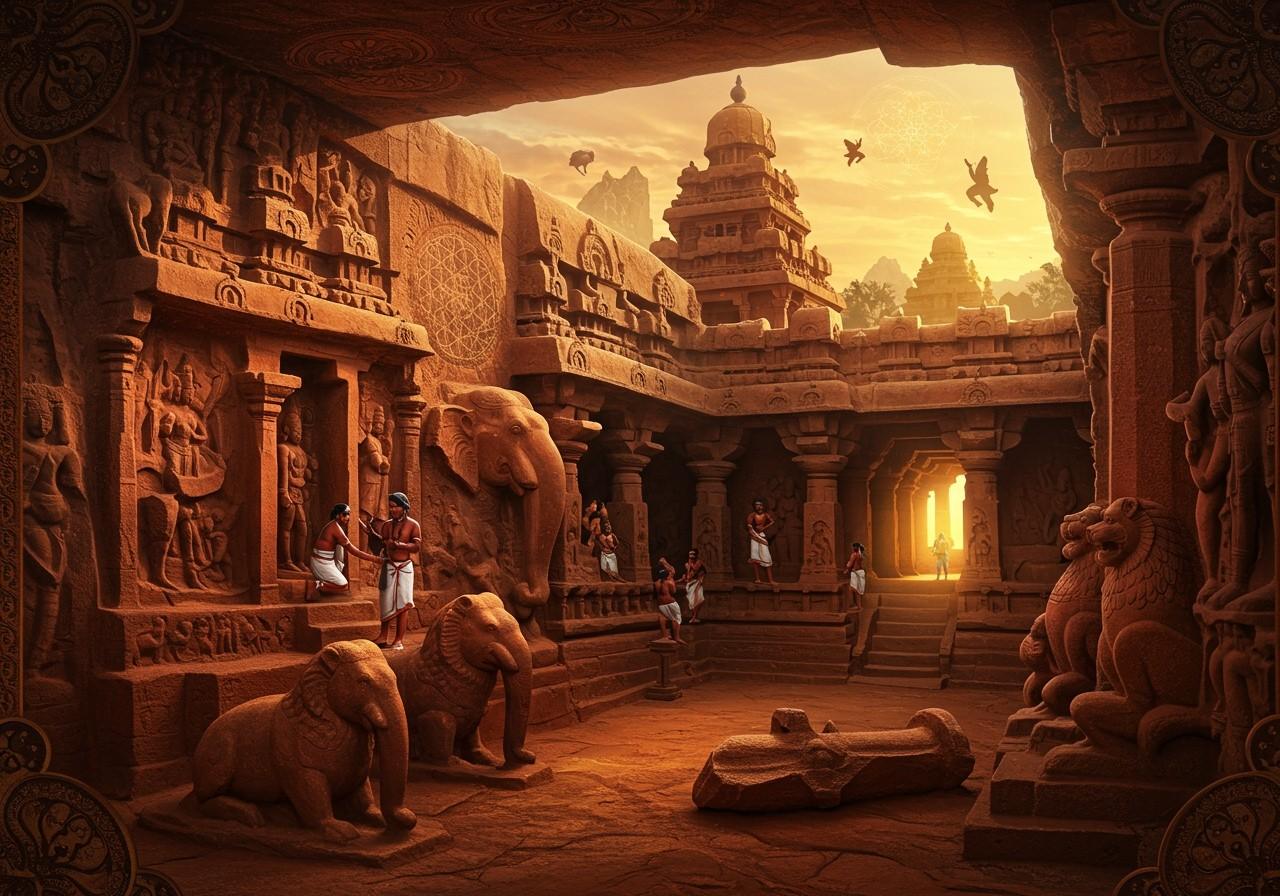
Mahendravarman I, a prominent Pallava king who reigned over South India from 600 to 630 CE, is celebrated for his significant contributions to architecture, particularly in Mamallapuram. His rule ushered in a golden age of temple building and rock-cut architecture for the Pallava dynasty. This article delves into the architectural wonders created during Mahendravarman I’s reign, exploring his unique style, the temples he built, and the enduring influence of his innovations on Indian architecture.
Historical Context
Mahendravarman I’s era witnessed a pivotal transition from wood-based to stone-based architecture. This period saw the rise of rock-cut temples, carved directly from natural rock formations. Understanding the socio-political landscape of the time provides valuable context for appreciating these architectural advancements. Religion played a central role in temple construction, and the Pallava dynasty’s patronage of arts and architecture proved instrumental in their development.
The Temples of Mahendravarman I
Mahendravarman I is credited with the construction of several important temples, most notably the rock-cut temples of Mamallapuram. These include:
- Mahishasuramardini Cave Temple: Renowned for its intricate carvings depicting deities, this temple showcases the skill and artistry of the Pallava period.
- Adivaraha Cave Temple: Featuring detailed sculptures and depictions of various gods, this cave temple is another example of Mahendravarman I’s architectural prowess.
These temples highlight his innovative use of natural rock formations and his attention to detail in the ornate carvings.
Architectural Style and Innovations
Mahendravarman I’s architectural style is distinguished by its pioneering use of rock-cut techniques and elaborate carvings. Key features of his style include:
- Monolithic structures: Carving entire temples from single rocks, a testament to the engineering skills of the time.
- Elaborate sculptures: Intricate and detailed carvings adorn the temples, depicting scenes from mythology and showcasing the artistry of the Pallava period.
- Integration of natural landscapes: The temples are harmoniously integrated with the surrounding natural environment, enhancing their beauty and spiritual significance.
These innovations laid the groundwork for later Pallava architecture and significantly influenced subsequent temple construction in South India. Pallava architecture in Mamallapuram represents an early stage of Dravidian architecture, which later flourished under the Chola Dynasty. The Pallavas pioneered stone and mortar temples, evolving from earlier brick and timber structures.
Mamallapuram: A Legacy of Mahendravarman I
Mamallapuram, also known as Mahabalipuram, is a UNESCO World Heritage site that stands as a testament to Mahendravarman I’s architectural genius. Notable structures include:
- Shore Temple: A beautiful example of Pallava architecture, the Shore Temple stands majestically on the coastline.
- Five Rathas (Pancha Rathas): These monolithic rock-cut temples, each carved to resemble a chariot, are a unique architectural marvel.
These monuments underscore the historical importance of Mamallapuram and how Mahendravarman I’s contributions have shaped its legacy. Mamallapuram, named after the Pallava ruler Narasimhavarman I (Mamalla), features significant rock-cut temples, monolithic rathas, and intricate stone carvings depicting mythological scenes. Research on Pallava monuments at Mamallapuram has provided substantial insights into their historical and artistic significance.
Impact on Later Architecture
Mahendravarman I’s architectural innovations had a profound and lasting impact on later South Indian architecture. His techniques and styles were embraced and adapted by subsequent Pallava rulers and other dynasties.
Cultural Significance
Mahendravarman I’s temples were not merely places of worship but also served as cultural centers promoting the arts. These structures symbolized royal power and piety, demonstrating the dynasty’s devotion and artistic skill.
Poojn.in: Supporting Your Temple Visits and Worship
Poojn.in offers a wide selection of essential puja items that connect you with the rich architectural and spiritual heritage of temples built during Mahendravarman I’s era. We provide:
- Pure copper and brass bells: Crafted to match traditional temple designs, our bells enhance the spiritual atmosphere of your puja.
- Authentic camphor and dhoop: Experience the traditional scents of temple rituals with our high-quality camphor and dhoop.
- Cotton wicks for temple-style oil lamps: Maintain the sanctity of your worship with our pure cotton wicks.
- Traditional brass and silver diyas: Illuminate your puja space with our authentic diyas, similar to those used in ancient temples.
- Pure cotton vastras (clothing) for deity worship: Dress your deities in our pure cotton vastras, adding to the reverence of your puja.
- Sandalwood and kumkum for traditional temple rituals: Complete your temple rituals with our pure sandalwood and kumkum.
Visit www.poojn.in to explore our complete collection of temple worship items. We deliver across India, bringing authentic puja supplies right to your doorstep. Shop Temple Worship Items at Poojn.in
Conclusion
Mahendravarman I’s architectural marvels stand as a timeless tribute to the Pallava dynasty’s creativity and devotion. His pioneering use of rock-cut techniques and intricate carvings not only revolutionized South Indian architecture but also left an enduring legacy that continues to inspire and captivate. The temples of Mamallapuram, with their breathtaking beauty and historical significance, remain a treasured part of India’s cultural heritage.


